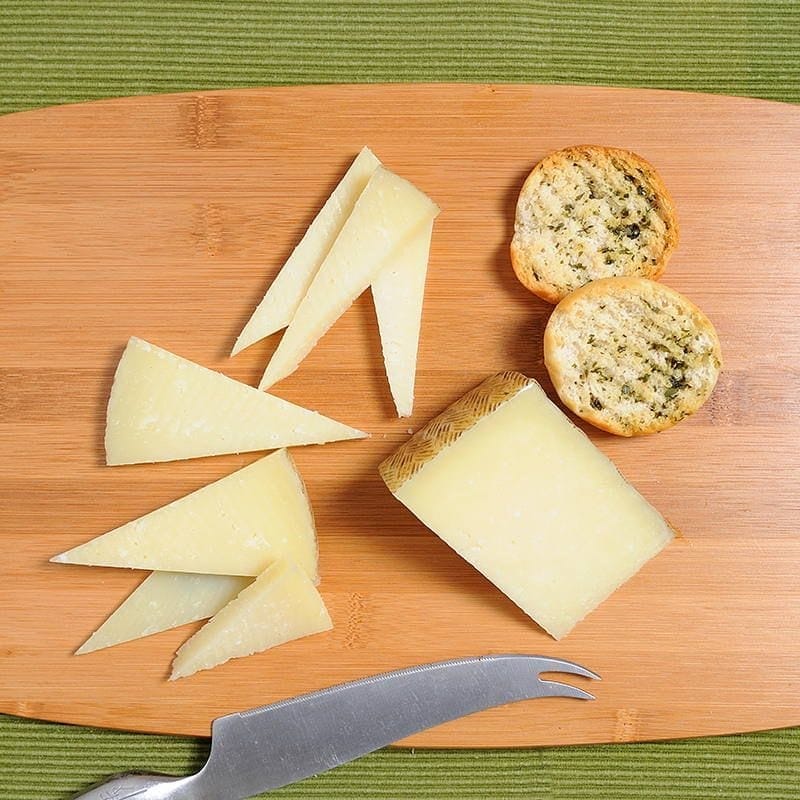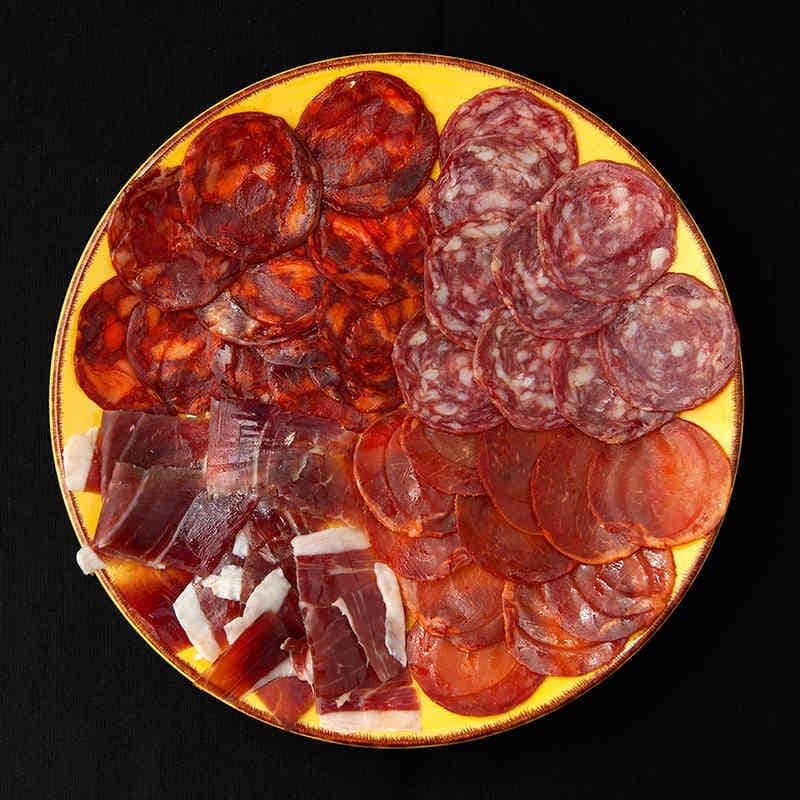In the culinary culture, a cheese and charcuterie board can be a magnificent choice for any meeting or event.
The presentation of a cheese and charcuterie board is not only a matter of taste, but also of art and elegance.
Below, I will provide you with a detailed guide on how to prepare a cheese and charcuterie board that will leave your guests wanting more.
Choosing the ingredients for your cheese and charcuterie board
Choosing the ingredients for your cheese and charcuterie board is a process that requires care and attention to detail. It is essential to strike a balance between different flavours and textures to deliver an unforgettable culinary experience.
Below, I will guide you through the selection of cheeses, charcuterie, including Serrano ham and Iberian ham, and other complements.
Selecting Spanish cheeses
Choosing cheeses for your board can seem daunting, but here are some tips to make it easier:
- Variety: try mixing cheeses from different regions and milks (cow, sheep, goat). A good option is Manchego cheese.
- Texture: choose soft cheeses such as camembert, semi-hard cheeses such as cheddar, and hard cheeses such as parmigiano-reggiano.
- Flavour: combine soft and creamy cheeses with more robust and spicy ones.
- Presentation: consider cutting the cheeses in different ways to enhance the appearance of the board.
Choosing the charcuterie
Charcuterie is just as important as cheese on a cheese and charcuterie board. Here are some tips on how to choose the best types of charcuterie:
- Diversity: diversity in charcuterie can make your board truly unique. Opt for salami, chorizo, mortadella, etc.
- Quality: the quality of the sausages can make a big difference. Look for fresh and well-prepared products.
Serrano and Iberian ham
Ham is a fundamental sausage on any charcuterie board, and in Spain there are two very famous types: Serrano ham and Iberian ham.
- Jamón serrano: this ham is cured in salt and dried for a minimum of 12 months. Its flavour is mild and slightly salty, and its firm texture makes it an excellent choice for the charcuterie and cheese board.
- Iberian ham: considered one of the most exquisite hams in the world, Iberian ham is produced from acorn-fed Iberian pigs. Its flavour is richer and its texture is smoother compared to Serrano ham.
Additional supplements
Don’t forget to add other foods to complement and enhance the cheese and charcuterie board:
- Fruits and nuts: grapes, figs, almonds and walnuts can add sweetness and texture.
- Bread and crackers: offer a variety of breads and crackers so guests can enjoy the cheeses and charcuterie.
- Condiments: chutneys, mustards and honey can offer interesting flavour contrasts.
The presentation of a cheese and charcuterie board can be an exciting and creative process.
With a careful selection and combination of cheeses, charcuterie, including Serrano and Iberico ham, and accompaniments, you can create a cheese and charcuterie board that is both visually impressive and deliciously satisfying.
How to prepare a cheese and charcuterie board
Preparing a cheese and charcuterie board is an art that combines aesthetics and taste. It requires not only careful selection of ingredients but also meticulous presentation.
Here’s how to prepare a cheese and charcuterie board that will not only delight the palate, but will also be a visual delight.
Step 1: Choose the board or tray
The basis of your presentation is fundamental, and this is where you should start:
- Size: make sure the board or tray is large enough to accommodate all the elements without feeling cramped.
- Material: you can choose from wood, marble, ceramic or other materials, depending on your style and preference.
- Shape: a round, rectangular or irregular board can add visual interest.
Step 2: place the cheeses and charcuterie
Strategic placement is key to a well-presented cheese and charcuterie board.
- Place the cheeses: start by placing the larger cheeses first and then fill in with the smaller cheeses. Consider the way they are cut to create visual appeal.
- Add the charcuterie: Charcuterie, such as Serrano ham and Iberian ham, should be placed on the board in a way that complements the cheeses. They can be rolled, folded or stacked to add texture.
- Organise by flavour: consider placing mild and strong flavours together to guide your guests through a tasting experience.
Step 3: Add complements
Add-ons add colour and flavour to the charcuterie and cheese board.
- Fruits and vegetables: place fresh fruits such as grapes, strawberries or pear slices near soft cheeses. Pickled vegetables can also add a tangy touch.
- Nuts and seeds: Nuts and almonds can add a crunchy texture and toasted flavour.
- Breads and crackers: Include different types of breads and crackers on the board to offer texture and flavour options.
Step 4: Decorate and personalise
Once everything is laid out on the board, it’s time to personalise and decorate.
- Labels: If possible, label each cheese and charcuterie, especially if you have guests with specific dietary preferences or restrictions.
- Garnish: add decorative elements such as sprigs of rosemary or edible flowers.
- Pairing: consider pairing the board with wines, beers or ciders that complement the flavours of the cheeses and charcuterie.
Final tips on how to make a Spanish cheese and charcuterie board
After carefully selecting your ingredients and preparing your cheese and charcuterie board with care, there are several additional tips that can make your cheese and charcuterie board truly exceptional.
These tips will help you add those finishing touches that can elevate your board to new heights.
Temperature and preparation time
- Cheese temperature: To fully enjoy the flavours and textures of the cheeses, remove them from the refrigerator at least one hour before serving. This will allow the cheeses to breathe and show their full character.
- Fresh cured meats: As with cheeses, cured meats such as ham should be served at room temperature to enhance their flavour.
Presentation and design
- Height and texture: Experiment with different heights and textures on the board. Use small bowls for mustards or jams, and create layers with cold meats and cheeses.
- Colour: Incorporate colourful elements such as fresh fruit, edible flowers or pickled vegetables to make the board visually appealing.
- Space: Don’t pile ingredients too high; leave space between them so guests can easily pick them up.
Pairings and accompaniments
- Wine pairing: If you are offering wine, consider pairings that complement the cheeses and charcuterie. A robust red wine might go well with strong cheeses, while a crisp white wine could complement soft cheeses.
- Offer alternatives: For those who do not consume alcohol, consider offering fresh juices or flavoured water.
Special considerations
- Allergies and dietary restrictions: If you have guests with allergies or dietary restrictions, be sure to clearly label ingredients or even offer a separate small board if necessary.
- Utensils: Provide appropriate utensils for each type of cheese and charcuterie. This includes knives for hard cheeses and forks or chopsticks for charcuterie.
Innovation and experimentation
- Be creative: Don’t be afraid to experiment with different combinations and flavours. Each cheese and charcuterie board is an opportunity to express your culinary style and creativity.
- Ask for feedback: If you are preparing the board for friends or family, ask for their opinions on their favourite cheeses or charcuterie to include on the board.
Conclusion
The presentation of a cheese and charcuterie board is a culinary tradition that goes beyond simply placing food on a plate. It is a sensory experience that invites you to explore a rich variety of flavours, textures and aromas.
From the meticulous selection of ingredients such as Serrano ham and Iberian ham to the careful arrangement on a well-designed board, each step in the creation of a cheese and charcuterie board is an exercise in creativity and culinary art.
We have explored how to choose the right cheeses and charcuterie, how to prepare and present the board, and how to add those finishing touches that make the board truly exceptional.
In addition, we have delved into the details and provided practical tips for customising the board to suit individual preferences and needs.
Creating a cheese and charcuterie board is not just a means to offer food to guests; it is an opportunity to celebrate the diversity of gastronomy and share a unique and memorable experience.
Whether for a special celebration or an intimate dinner party, you now have the tools and know-how to create a charcuterie and cheese board that not only satisfies the palate, but also delights the eyes and enriches the connection between friends and family.
With love, care and a touch of creativity, your cheese and charcuterie board can be a true culinary gem.








